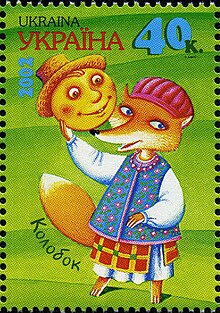From the thick, fat pancake
Vom thick fat pancake ( ATU 2025, also: The thick fat pancake , De thick fette Pannkoken or The thick fat Pannekauken ) is a fairy tale that is known in several linguistic areas of Europe and was published in various fairy tale collections in the middle of the 19th century. It is about a pancake that has come to life and escapes from its cookers into a forest, where it encounters various animals who want to eat it. At each subsequent encounter with another animal, the pancake lists the creatures it had met up to then.
Frames
Fairy tales and legends from Hanover
In 1854 Carl and Theodor Colshorn published their collection of fairy tales and legends from Hanover . With Vom thick fetten Pfannekuchen, the book contains a form of the fairy tale passed down orally from Salzdahlum . The literal speech of the text is in Low German ("Big fat Pannekauken, blief stahn, eck wants to diet!"). In contrast to most other versions of the fairy tale, the pancake in Colshorn's lore is represented with a pair of legs . They use an onomatopoeic “ran kanntapper, kanntapper” to show the pancake's form of locomotion with a kind of gallop . The text describes “three old women” as cooks. Bunny Wippsteert , Wulf Dicksteert , Zicke Langbart , Perd Plattfaut and Su Haff are the names of the animals the pancake encountered. At the end of the story, the pancake meets three hungry orphans and is eaten by them.
Breakdowns
Peter Christen Asbjørnsen published his collection of fairy tales Norske Folkeeventyr in Norway in the early 1840s , which contains the text Pannekaken . Asbjørnsen's version describes a mother who bakes pancakes for her seven children. Due to a slip of the tongue from the mother, the pancake comes alive and rolls ("trillet og trillet") out of the house. The fairy tale ends when a pig sneaks the trust of the pancake and then eats it.
Kolobok
Alexander Nikolayevich Afanassjew also published a similar text in his collection of Russian folk tales . The main character, however, is represented by a rolling dumpling that sings a song to each of the animals that are hit in the manner of a chain fairy tale (term for a fairy tale that repeatedly strings together motifs or parts of the plot to form episodes). This version also ends with a ruse and the lump is eaten.
In the other Slavic languages, the name of the main character and title of the fairy tale appear different. Kolobok (Cyrillic Колобок) is a diminutive form of Kolob (Cyrillic Колоб), a type of fried bread known since 1610. In the Czech language, the fairy tale is called O Koblížkovi with the main character Koblížek, a diminutive of the Pączki- like Kobliha . In the Slovak language, the fairy tale is then called O Pampúchovi with the main character Pampúšik, a diminutive of Pampúch - the relationship between the names and Pączki can be seen via the Ukrainian Pampuchki.
Kolobok smileys
The traditional representation in Eastern European fairy tale books as a yellow lump with a face meant that the graphic representation of smileys as a yellow face is often referred to as Kolobok on the Internet . In this international usage, the name Kolobok is also unchangeable, while otherwise the main character of the Eastern European fairy tale appears linguistically adapted.
Related fairy tales
The basic idea of the food that runs away was processed in the English-speaking world in the story of the Gingerbread Man . The main character here is a gingerbread man , and this gingerbread man is running away.
Web links
- From the thick, fat pancake (text on Projekt Gutenberg-DE )
- From the big fat pancake (text on Zeno.org )
- Pannekaken ( Runeberg project )
Individual evidence
- ↑ Universal Lexicon
- ↑ Fairy tale The Pancake (PDF; 27 kB) at maerchenfrank.de
- ↑ Ivan Egorovich Zabelin: Домашний быт русских царей в XVI и XVII столетиях Domashniĭ byt russkikh t ︠ s ︡ areĭ v XVI i XVII stoletii ︠ a ︡ kh . Tranzitkniga, Moscow 2005, ISBN 5-9578-2773-8 , p. 803 (Russian).
